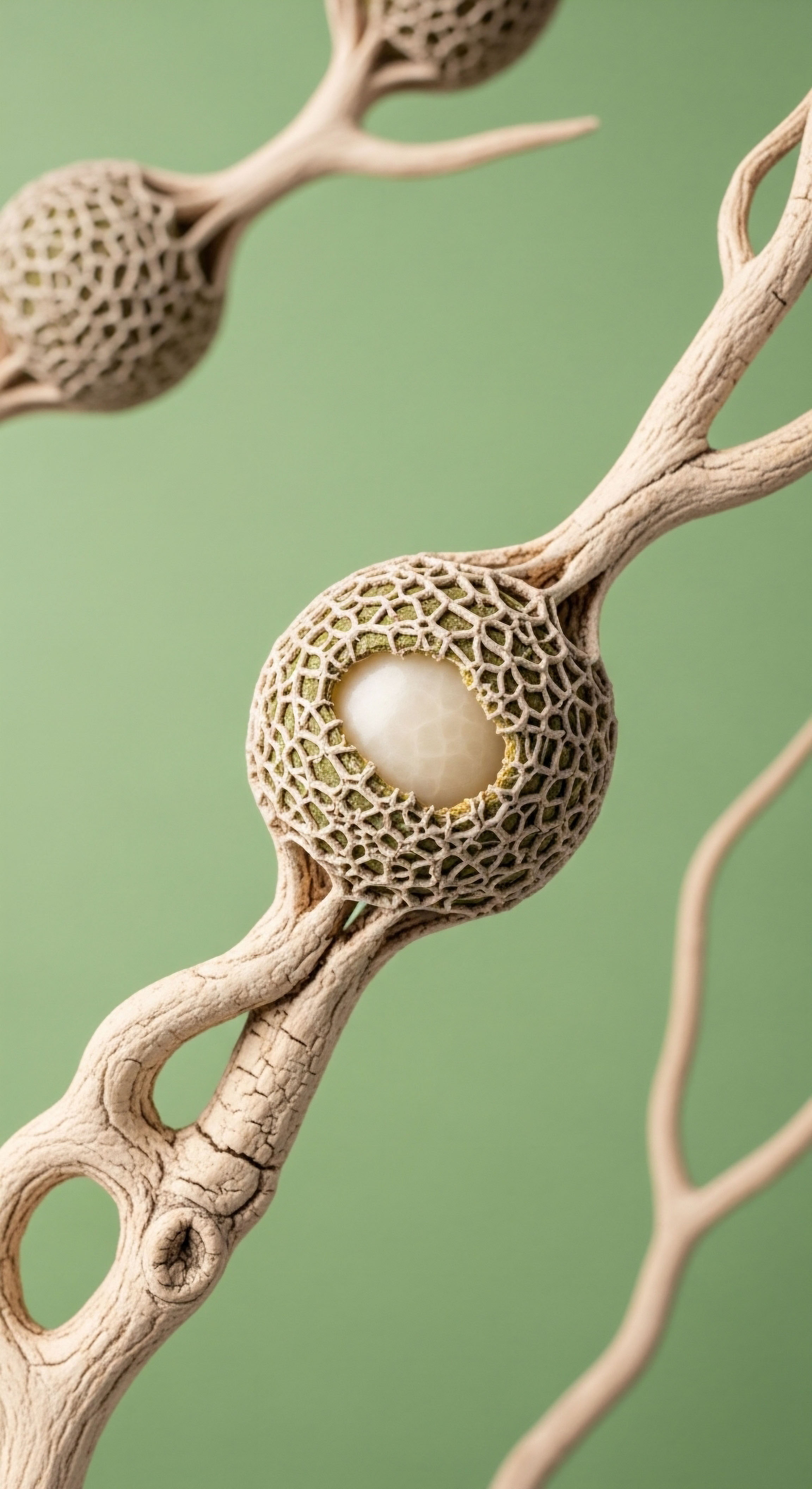

Fundamentals
Receiving a diagnosis of hypogonadism can feel like a verdict has been passed on your vitality. You may have been grappling with a persistent lack of energy, a noticeable decline in physical strength, a creeping mental fog, or a frustrating dip in libido. These experiences are real, and they are valid.
The clinical term ‘hypogonadism’ simply provides a name for the biological reality underlying these feelings ∞ your body’s production of testosterone has fallen below the threshold required for optimal function. This moment of diagnosis is a starting point. It is the point where we begin to translate your lived experience into a clear biological map, and with that map, we can chart a course forward.
The central question then becomes, what is driving this decline? The male endocrine system, the intricate communication network that governs hormone production, can be viewed like a complex and finely tuned orchestra. For this orchestra to produce its symphony of well-being, every section must perform its part correctly and in coordination.
Testosterone production is a collaborative effort, a conversation between your brain and your testes, a process known as the Hypothalamic-Pituitary-Gonadal (HPG) axis. The hypothalamus acts as the conductor, sending a rhythmic signal (Gonadotropin-Releasing Hormone, or GnRH) to the pituitary gland.
The pituitary, the lead violin, responds by releasing its own signaling molecules (Luteinizing Hormone, or LH, and Follicle-Stimulating Hormone, or FSH) into the bloodstream. When LH reaches the testes, it instructs specialized Leydig cells to produce testosterone. This testosterone then travels throughout the body to carry out its myriad functions, while also sending a feedback signal back to the brain to moderate the symphony’s tempo.
The distinction between organic and functional hypogonadism separates conditions of permanent damage from those of a potentially reversible systemic imbalance.

Understanding the Nature of the Disruption
When this system falters, we must first understand the nature of the problem. Medical science distinguishes between two primary types of hypogonadism, and this distinction is profoundly important for your path forward.
- Organic Hypogonadism ∞ This form involves direct, physical damage to one of the components of the HPG axis. It could be a genetic condition, a physical injury to the testes, or damage to the pituitary gland from a tumor or radiation. In our orchestra analogy, this is like a broken instrument. The conductor and the sheet music can be perfect, but if the cello is cracked, it cannot produce the right sound. This condition is typically irreversible and requires external support, such as Testosterone Replacement Therapy (TRT), to restore hormonal balance.
- Functional Hypogonadism ∞ This form is different. The instruments of the orchestra, the hypothalamus, pituitary, and testes, are all physically intact and capable of performing. The issue lies with external pressures and systemic static that are disrupting their communication and function. It is a condition of dysregulation, a symphony thrown into disarray by poor acoustics and external noise. This ‘noise’ is generated by modern lifestyle factors ∞ chronic stress, poor sleep quality, metabolic distress from suboptimal nutrition, and a sedentary existence. This form of hypogonadism is considered potentially reversible because if you can eliminate the disruptive noise, the orchestra can often find its rhythm again.
The journey to reclaim your vitality begins with this understanding. The fatigue and low mood you feel are not just abstract complaints; they are signals from your body that the communication along the HPG axis has been compromised. The challenge, and the opportunity, lies in identifying the sources of that systemic static.
Lifestyle interventions are the tools we use to methodically quiet the noise, allowing the body’s innate hormonal intelligence to re-emerge. This process is about restoring the body’s internal environment to one that supports and promotes healthy endocrine function, giving your own biological systems the chance to perform as they were designed.


Intermediate
To effectively address functional hypogonadism, we must move beyond acknowledging that lifestyle matters and examine precisely how it exerts its influence on the Hypothalamic-Pituitary-Gonadal (HPG) axis. This biological feedback loop is the operational core of male hormonal health. Its function is elegant in its design, operating much like a sophisticated thermostat system that maintains homeostasis.
The hypothalamus senses the body’s need for testosterone and releases GnRH in carefully timed pulses. This pulsatility is critical. A steady flood of GnRH would desensitize the pituitary, while a rhythmic pulse keeps it responsive. The pituitary then releases LH, which travels to the testes to stimulate testosterone production.
The resulting circulating testosterone provides feedback to the hypothalamus and pituitary, signaling them to moderate GnRH and LH release, thus completing the loop. Functional hypogonadism arises when this delicate, pulsatile communication is chronically disrupted.

Metabolic Health as the Endocrine Foundation
One of the most powerful disruptors of the HPG axis is metabolic dysfunction, particularly insulin resistance and the accumulation of visceral adipose tissue (fat around the organs). This type of fat tissue is not a passive storage depot for energy. It is an active endocrine organ in its own right, secreting a host of inflammatory molecules and hormones that directly interfere with testosterone production.
A key mechanism here is the enzyme aromatase. Visceral fat is rich in aromatase, which has one primary job ∞ to convert testosterone into estradiol, a form of estrogen. When a man carries excess visceral fat, this conversion process goes into overdrive. The resulting elevated estradiol levels send a powerful suppressive signal back to the hypothalamus and pituitary.
The system is tricked into thinking testosterone levels are adequate or even high, causing the hypothalamus to slow its GnRH pulse and the pituitary to reduce LH output. The testes, receiving a weaker signal, produce less testosterone. This creates a vicious cycle ∞ low testosterone encourages more visceral fat storage, which in turn leads to more aromatase activity and even lower testosterone. Lifestyle changes that reduce visceral fat and improve insulin sensitivity directly attack this cycle at its root.

How Do Lifestyle Factors Impact the HPG Axis?
Each lifestyle choice can either support or undermine the integrity of this hormonal thermostat. Understanding these connections provides a clear rationale for targeted interventions.
- Nutrition and Weight Management ∞ A diet high in processed foods and refined sugars drives insulin resistance. Chronically high insulin levels are linked to reduced LH pulsatility and lower testosterone. Conversely, a diet rich in whole foods, healthy fats, and adequate protein helps restore insulin sensitivity. Weight loss, particularly the reduction of visceral fat, is the single most effective intervention for reducing aromatase activity and removing the estrogenic brake on the HPG axis.
- Physical Activity ∞ Both resistance training and high-intensity interval training have been shown to acutely boost testosterone levels. More importantly, consistent exercise improves body composition, increases insulin sensitivity, and reduces systemic inflammation. Endurance exercise, in particular, has been shown to revert metabolic syndrome-induced hypogonadism in animal models by reducing inflammation in the hypothalamus itself. The goal of physical activity is to recalibrate the body’s metabolic machinery, making it more efficient and less inflammatory.
- Sleep Architecture ∞ The majority of testosterone is produced during sleep, specifically tied to deep sleep cycles. The primary GnRH pulse that initiates the daily rise in testosterone occurs shortly after sleep onset. Chronic sleep deprivation, fragmented sleep, or conditions like sleep apnea directly blunt this critical signaling process. Restoring a healthy sleep schedule of 7-9 hours per night is a non-negotiable pillar of hormonal optimization.
- Stress Modulation ∞ Psychological or physiological stress activates a parallel system ∞ the Hypothalamic-Pituitary-Adrenal (HPA) axis, which governs the release of the stress hormone cortisol. The HPA and HPG axes have a reciprocal relationship. Chronically elevated cortisol acts as a powerful suppressor of the HPG axis, inhibiting GnRH release from the hypothalamus and directly reducing testosterone synthesis in the testes. This is a primal survival mechanism; in times of famine or danger, the body prioritizes immediate survival over reproductive function. In the modern world, chronic work stress or emotional distress can keep this suppressive pathway constantly engaged.
Reducing visceral adipose tissue through diet and exercise is the most direct way to decrease the aromatization of testosterone into estrogen, thereby restoring proper signaling within the HPG axis.

A Comparison of Primary Lifestyle Interventions
While all pillars are interconnected, they can have different primary effects on the pathway to reversing functional hypogonadism. Understanding these nuances allows for a more strategic approach.
| Intervention | Primary Mechanism of Action | Supporting Mechanisms | Typical Timeframe for Effect |
|---|---|---|---|
| Caloric Deficit & Weight Loss | Reduces aromatase activity from visceral fat, decreasing estrogenic suppression of the HPG axis. | Improves insulin sensitivity, reduces systemic inflammation. | Months to a year, dependent on amount of weight to lose. |
| Resistance Training | Increases muscle mass, which improves insulin sensitivity and metabolic rate. | Provides acute testosterone boosts, reduces cortisol. | Weeks to months for metabolic improvements. |
| Sleep Optimization | Allows for proper nocturnal GnRH and LH pulsatility, maximizing natural testosterone production cycles. | Reduces cortisol, improves insulin sensitivity. | Days to weeks for hormonal rhythm restoration. |
| Micronutrient Sufficiency | Provides essential co-factors like Zinc and Vitamin D, which are direct substrates for testosterone synthesis in the testes. | Supports overall metabolic and immune function. | Weeks to months to correct deficiencies. |
The reversal of functional hypogonadism through lifestyle is a process of removing the layers of interference that are holding the system back. It is a systematic effort to create an internal environment where the HPG axis is free to operate as intended, unburdened by metabolic, inflammatory, and stress-induced static.


Academic
A sophisticated analysis of functional hypogonadism requires moving from a systems overview to a molecular and cellular examination of its etiology. The prevailing academic consensus positions functional hypogonadism as a state of adaptive, yet ultimately maladaptive, neuroendocrine shutdown driven by systemic metabolic inflammation.
The central node of this dysfunction is the hypothalamus, specifically the arcuate nucleus, where the delicate machinery governing GnRH pulsatility is exquisitely sensitive to peripheral metabolic signals. The conversation between the body’s energy status and its reproductive capacity is arbitrated at this neural nexus, and its disruption is the core pathology.

The Role of Kisspeptin Neurons as Master Regulators
Initial models of the HPG axis focused on direct feedback of sex steroids on GnRH neurons. Current understanding, however, has placed a population of intermediary neurons, known as kisspeptin neurons (expressing the Kiss1 gene), as the primary drivers of GnRH secretion. These neurons act as the immediate upstream activators of GnRH neurons.
They integrate a vast array of peripheral signals, including sex steroids, leptin, and inflammatory cytokines, and translate that information into the precise, rhythmic stimulation that GnRH neurons require. In functional hypogonadism, the failure is often located at the level of these kisspeptin neurons. They become suppressed, leading to a weak and disorganized signal to the GnRH neurons, which in turn results in attenuated LH pulses and diminished testicular testosterone output.

What Is the Molecular Basis of Kisspeptin Suppression in Obesity?
The metabolic syndrome associated with obesity creates a profoundly inflammatory internal environment that directly impairs kisspeptin function through several convergent pathways:
- Leptin Resistance ∞ In a healthy individual, the adipokine leptin, secreted by fat cells, signals energy sufficiency to the hypothalamus and is a permissive factor for reproductive function, stimulating kisspeptin neurons. In obesity, however, chronic hyperleptinemia leads to central leptin resistance. The hypothalamus becomes deaf to the leptin signal. The kisspeptin neurons, deprived of this crucial “energy is plentiful” signal, reduce their firing rate, effectively putting a brake on the entire HPG axis as a protective measure against perceived energy deficit.
- Pro-Inflammatory Cytokines ∞ Visceral adipose tissue is a major source of pro-inflammatory cytokines such as Tumor Necrosis Factor-alpha (TNF-α) and Interleukin-6 (IL-6). These molecules can cross the blood-brain barrier and directly induce a state of hypothalamic inflammation. This neuroinflammation activates local microglial cells and astrocytes, creating a cellular environment that is toxic to optimal neuronal function. Both TNF-α and IL-6 have been shown in vitro and in vivo to directly suppress the expression of the Kiss1 gene and inhibit the electrical activity of kisspeptin neurons.
- Insulin Resistance and Hyperinsulinemia ∞ While the role of insulin in the central regulation of reproduction is complex, chronic hyperinsulinemia, a hallmark of metabolic syndrome, contributes to the state of low-grade systemic inflammation. Furthermore, central insulin resistance within the hypothalamus itself disrupts the cell’s ability to properly sense and respond to energy fluxes, further contributing to the dysregulation of the neurons that govern GnRH release.
The suppression of kisspeptin neuron activity by leptin resistance and pro-inflammatory cytokines is the central molecular event leading to the attenuated GnRH pulsatility seen in functional hypogonadism.

Cellular Players in Functional Hypogonadism
A clear understanding of the pathology requires appreciating the roles of different cells and tissues in this systemic breakdown.
| Cell/Tissue Type | Function in Health | Dysfunction in Functional Hypogonadism | Mechanism of Impairment |
|---|---|---|---|
| Kisspeptin Neurons (ARC) | Integrate metabolic and hormonal signals; provide primary pulsatile drive to GnRH neurons. | Reduced firing rate and Kiss1 gene expression. | Suppressed by leptin resistance and inflammatory cytokines (TNF-α, IL-6). |
| GnRH Neurons (Hypothalamus) | Release GnRH in a pulsatile manner into the hypophyseal portal system. | Receive a weak, disorganized upstream signal, leading to attenuated GnRH pulses. | Secondary to kisspeptin neuron suppression. |
| Gonadotrophs (Pituitary) | Respond to GnRH pulses by synthesizing and releasing LH and FSH. | Under-stimulated, leading to reduced LH pulse amplitude and frequency. | Insufficient GnRH signal from the hypothalamus. |
| Leydig Cells (Testes) | Respond to LH by synthesizing testosterone from cholesterol. | Receive a diminished LH signal, resulting in decreased testosterone synthesis. | Insufficient stimulation from the pituitary. |
| Adipocytes (Visceral Fat) | Store energy; secrete adipokines like leptin. | Become hypertrophic, inflamed, and secrete excess inflammatory cytokines and aromatase. | Chronic positive energy balance and insulin resistance. |

Can Lifestyle Changes Reverse These Molecular Pathologies?
The potential for reversibility is grounded in the plasticity of these systems. Lifestyle interventions, particularly significant weight loss achieved through caloric restriction and exercise, directly counteract these pathologies at the molecular level. Weight loss reduces the mass of visceral adipose tissue, thereby decreasing the primary source of both aromatase and pro-inflammatory cytokines.
As systemic inflammation subsides, the inflammatory pressure on the hypothalamus is relieved. Concurrently, improved diet and exercise restore insulin and leptin sensitivity. With these suppressive signals removed and sensitizing signals restored, kisspeptin neurons can resume their intrinsic rhythmic firing.
This restoration of the upstream signal re-establishes organized GnRH pulsatility, leading to normalized LH secretion and a subsequent increase in endogenous testosterone production by the testes. The reversal is a direct consequence of restoring metabolic homeostasis, which allows the neuroendocrine architecture of the HPG axis to function without interference.

References
- Corona, G. et al. “Treatment of Functional Hypogonadism Besides Pharmacological Substitution.” World Journal of Men’s Health, vol. 38, no. 3, 2020, pp. 276-292.
- Rastrelli, G. et al. “Functional Male Hypogonadism ∞ A Common Condition with Modifiable Risk Factors.” Journal of Endocrinological Investigation, vol. 42, no. 7, 2019, pp. 757-773.
- Cohen, P.G. “The role of aromatase in the pathogenesis of obesity-related male hypogonadism.” Medical Hypotheses, vol. 77, no. 1, 2011, pp. 85-87.
- Grossmann, M. & Matsumoto, A. M. “A Perspective on Middle-Aged and Older Men with Functional Hypogonadism ∞ Focus on Holistic Management.” The Journal of Clinical Endocrinology & Metabolism, vol. 102, no. 3, 2017, pp. 1067-1075.
- George, A. & Tajar, A. “The hypothalamic-pituitary-gonadal axis in men with schizophrenia.” International Journal of Molecular Sciences, vol. 24, no. 7, 2023, p. 6492.
- Pilz, S. et al. “Effect of vitamin D supplementation on testosterone levels in men.” Hormone and Metabolic Research, vol. 43, no. 3, 2011, pp. 223-225.
- Prasad, A. S. et al. “Zinc status and serum testosterone levels of healthy adults.” Nutrition, vol. 12, no. 5, 1996, pp. 344-348.
- Kelly, D. M. & Jones, T. H. “Testosterone and obesity.” Obesity Reviews, vol. 16, no. 7, 2015, pp. 581-606.
- George, J. T. et al. “Kisspeptin and the regulation of the reproductive axis in man.” Clinical Endocrinology, vol. 79, no. 1, 2013, pp. 1-9.
- Jais, A. & Brüning, J. C. “Hypothalamic inflammation in obesity and metabolic disease.” The Journal of Clinical Investigation, vol. 127, no. 1, 2017, pp. 24-32.

Reflection

Translating Knowledge into Personal Protocol
You have now journeyed from the felt sense of your symptoms to the molecular cross-talk occurring deep within your brain. You understand that functional hypogonadism is a state of systemic disharmony, where the body’s own communication lines have been disrupted by the pressures of its environment. This knowledge is powerful. It shifts the perspective from one of a fixed disease to one of a dynamic condition, a condition that can be influenced and potentially reversed by changing the inputs.
The path forward involves seeing your daily choices through this new lens. The food you eat, the quality of your sleep, the way you move your body, and the stress you carry are all direct messages you are sending to your endocrine system.
They are instructions that either quiet or amplify the static interfering with your hormonal symphony. The process of reversing functional hypogonadism is the process of learning to speak your body’s language, a language of metabolic health and hormonal balance.
This understanding is the map. The journey, however, is deeply personal. While the principles are universal, their application must be tailored to your unique biology, your life circumstances, and your goals. The information presented here is the beginning of a new conversation with your body and with the clinical professionals who can partner with you.
The ultimate goal is to move from a state of passive suffering to one of active, informed participation in your own health, reclaiming your vitality one intentional choice at a time.



